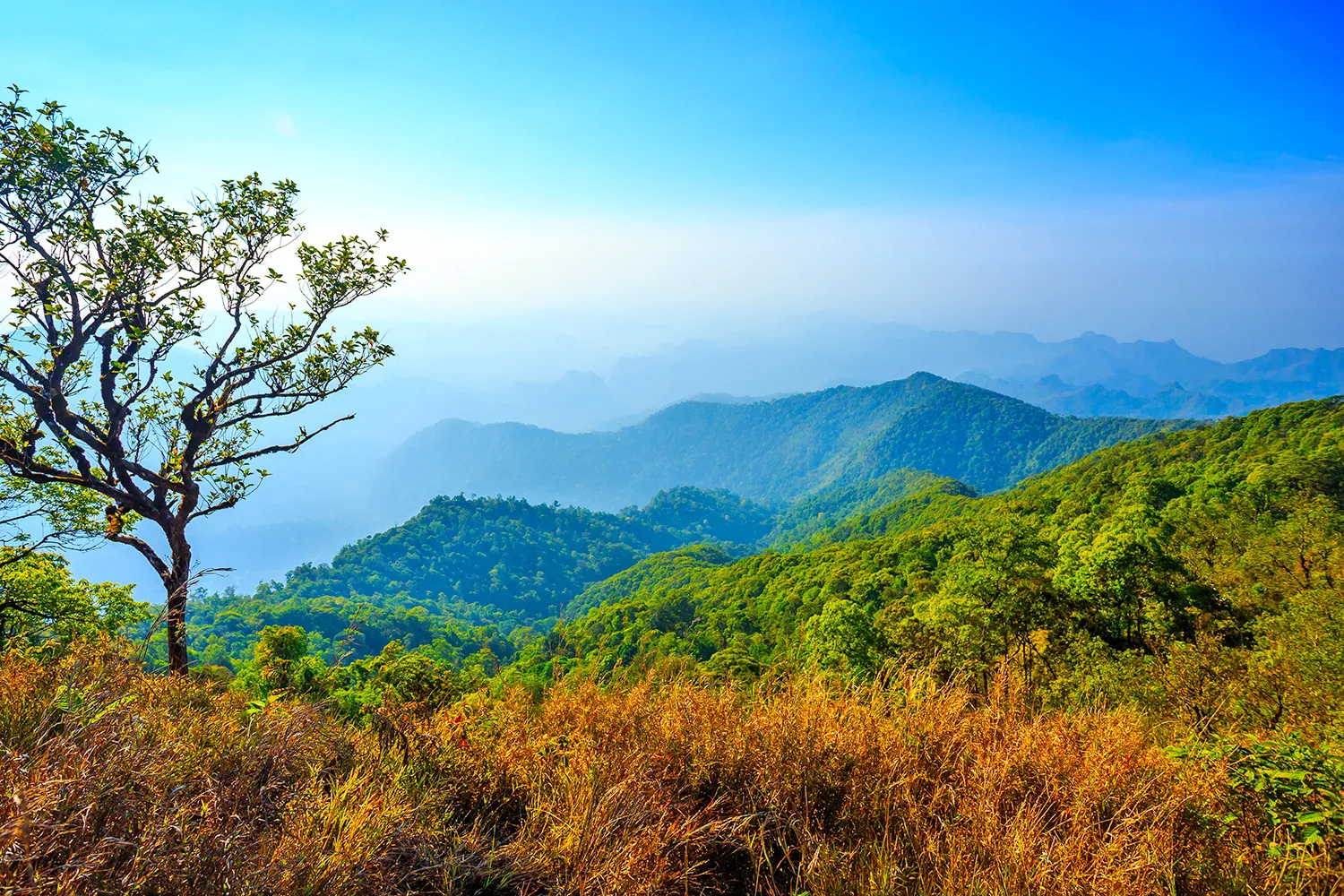Pai Tourist Attractions:
Nestled within the embrace of Mae Hong Son province lies the captivating district of Pai, an irresistible magnet for tourists yearning to explore its mesmerizing beauty. With an innate ability to draw in throngs of visitors annually, Pai stands as a testament to the allure of unspoiled landscapes and cultural richness. Pai’s unique appeal lies in its unblemished natural landscapes, coupled with the captivating traditions of its inhabitants, creating a symphony of sights and experiences that linger in the hearts of all who venture here. The district’s magnetic pull is such that tourists, both seasoned and novices, find themselves irresistibly drawn to its tranquil valleys, majestic peaks, and vibrant local customs. As the pages of time turn, the charm of Pai only deepens, offering an enticing tapestry of exploration and relaxation. From traversing lush hiking trails to engaging with the warm local community, every moment spent in Pai is a testament to its unyielding allure. Whether seeking adventure or a sanctuary of serenity, the district delivers an experience tailored to every traveler’s desire. In summation, Pai emerges as an enchanting district within Mae Hong Son province, a haven that beckons travelers from near and far to partake in its magical embrace. With an unceasing influx of globetrotters each year, Pai continues to enchant, offering an unforgettable sojourn amidst nature’s splendor and cultural wonders. Whether you are an adventurer in search of novelty or a seeker of tranquility, Pai welcomes all with open arms, promising an odyssey of enchantment that knows no bounds.
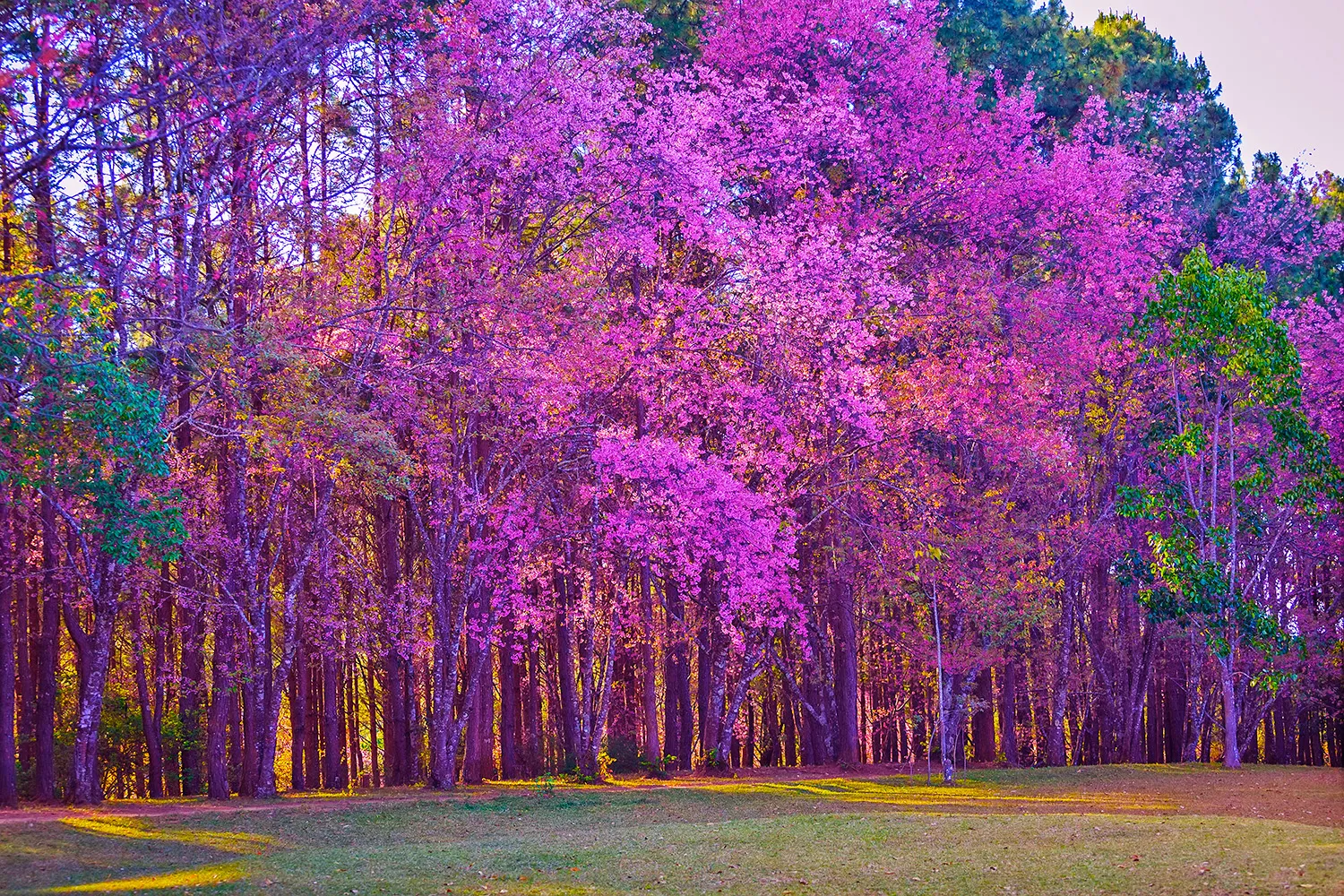
Huai Nam Dang National Park:
Situated a mere 40 km from Pai district, Huai Nam Dang National Park resides in the Wiang Nua sub-district, nestled at the fringes of Pai district while sharing a border with Chiang Mai province’s Mae Tang district. This natural haven beckons tourists throughout the year, with a particularly enchanting allure during the brisk cold season’s onset, as the crisp zephyrs sweep through the landscape. An exquisite spectacle unfolds as the park bursts into a kaleidoscope of winter blossoms, seemingly extending a warm welcome to the influx of visitors. For those who embark on this journey, the park offers a tranquil retreat where the embrace of nature’s beauty can be savored in every season. Of special note is the cold season, which sees the park adorned with an array of vibrant winter flowers. These blooms, in their splendid diversity, stand as a gracious salutation to the travelers who venture forth to behold their magnificence.
To fully immerse oneself in the park’s enchantment, an overnight stay proves rewarding. The park graciously provides a rest-house service that extends a hospitable shelter to weary travelers. Here, under the tranquil canopy of the night sky, visitors can await the magical spectacle of morning fog that often graces the landscape. It’s an experience that invites contemplation and wonder, offering a serene encounter with nature’s mysteries. However, given the popularity of the rest-house, securing a reservation can sometimes prove challenging, particularly during peak periods. For those who encounter such circumstances, an alternative approach presents itself. Travelers can opt to stay overnight within Pai itself, embarking on a refreshing morning sojourn to witness the ethereal veil of mist unfurling over Huai Nam Dang National Park. This offers an equally mesmerizing vista of nature’s grandeur, promising an enchanting experience that lingers in the memory.
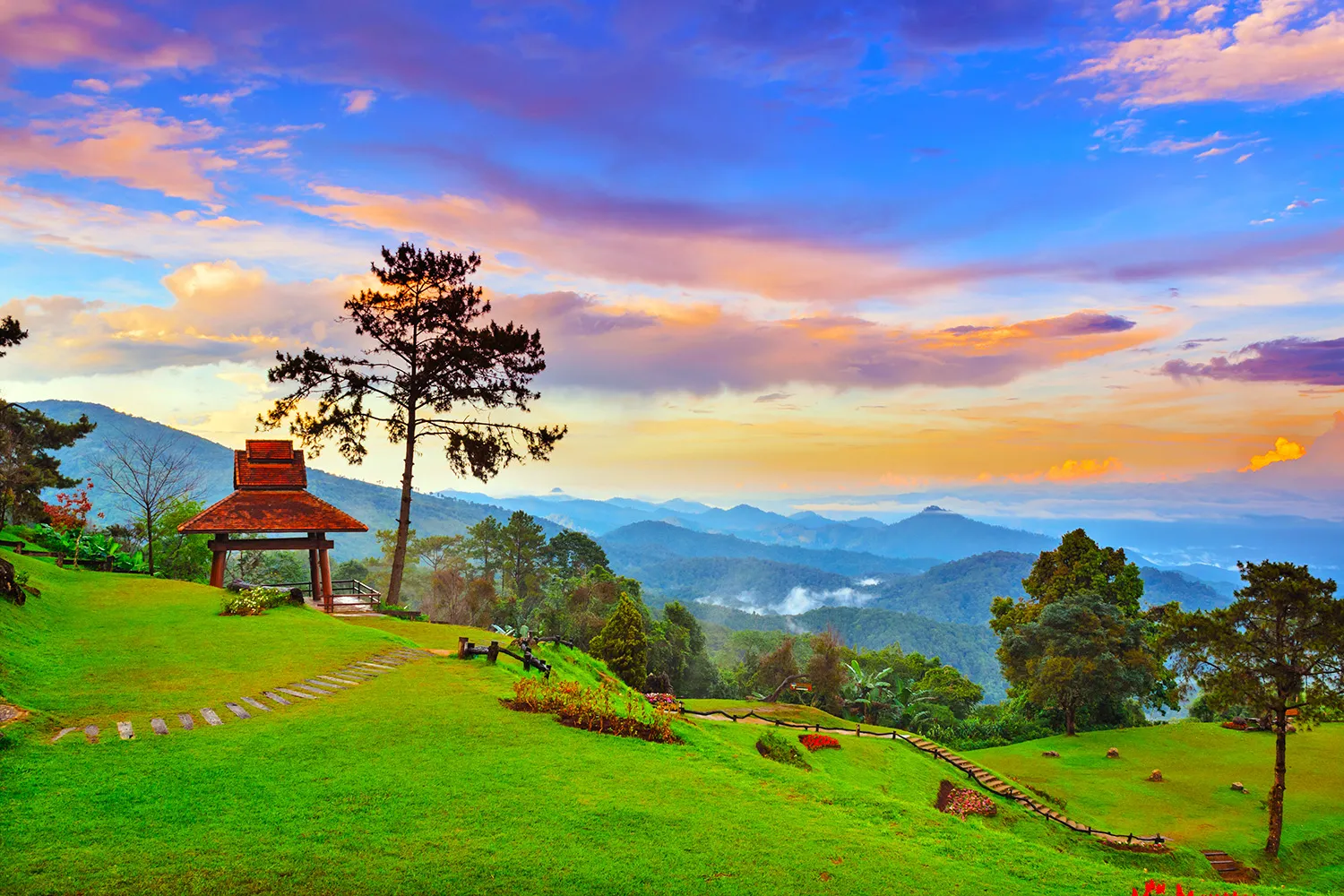
Khun Mae Ya Watershed Management Unit:
Encompassing regions in two provinces, Chiang Mai and Mae Hong Son, the Khun Mae Ya Watershed Management Unit extends its reach over the Mae Hi Subdistrict of Pai District in Mae Hong Son Province and the Pa Pae Subdistrict of Mae Taeng District in Chiang Mai Province. This expansive territory boasts an elevation of approximately 2,000 meters above sea level. Nestled within this unit lies a hidden treasure in Thailand – the captivating Wild Himalayan Cherry Blossom. This delicate floral phenomenon graces the landscape with its enchanting presence every January, adorning both grand and petite mountains across a vast expanse. Beyond the allure of these blossoms, the panorama of intricately arranged mountains adds to the visual splendor. The Khun Mae Ya Watershed Management Unit presents a picturesque vista that is as breathtaking as it is harmonious.
Travelers who embark on a journey to the Khun Mae Ya Watershed Management Unit are advised to opt for four-wheel-drive vehicles. This recommendation stems from the nature of the road leading to the unit, characterized by its narrowness and steep inclines. For those who find self-driving inconvenient, a viable alternative is to park at a designated fork and proceed into the management unit in the company of local drivers. These drivers, ever accommodating, are available daily to ferry travelers into the heart of the Khun Mae Ya Watershed Management Unit. Accommodations within the unit are limited in scope, offering no formal lodgings. Instead, the facility caters to outdoor enthusiasts with designated areas for tent pitching and restroom facilities. Travelers seeking an overnight experience should equip themselves with personal tents and camping gear to fully enjoy their stay amid nature’s embrace.
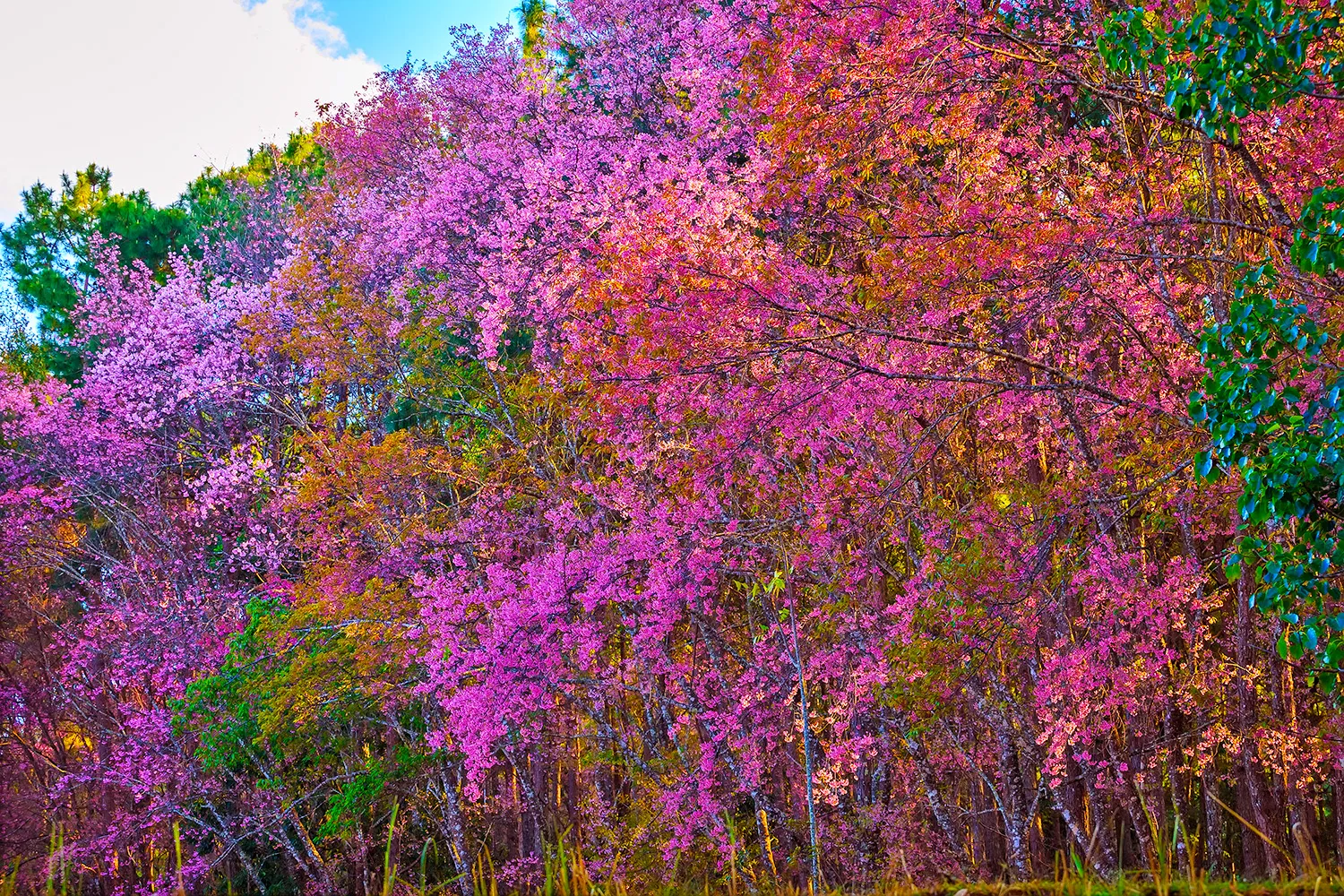
Coffee In Love:
Nestled within Pai District, Coffee In Love stands as another illustrious gem on the tourist map. This charming coffee establishment boasts an inviting ambiance and is perched atop a gentle hillock along the Highway No. 1095, part of the Chiang Mai Pai routes, just before entering the heart of Pai town. It emerges as more than a mere coffee shop; it is an experience woven into the fabric of the Pai journey. The very essence of Coffee In Love lies in its ability to provide a sanctuary where visitors can not only savor a cup of fine coffee but also bask in the embrace of its enchanting surroundings. This haven of taste and aesthetics evokes an atmosphere that oozes romance, compelling travelers on their Pai expeditions to halt and capture its allure in photographs. The seamless fusion of cafe décor and picturesque vistas casts a spell that is irresistible. Moreover, Coffee In Love extends its offerings beyond the visual feast. The establishment prides itself on serving exceptional coffee, a testament to the care and expertise that goes into each cup. Accompanying this liquid delight is an array of delectable culinary offerings, elevating the experience to a holistic indulgence of the senses. For those in search of souvenirs or keepsakes, the establishment also extends an invitation to explore a curated selection of items, ensuring that travelers can relish the memory of Coffee In Love even after they depart.
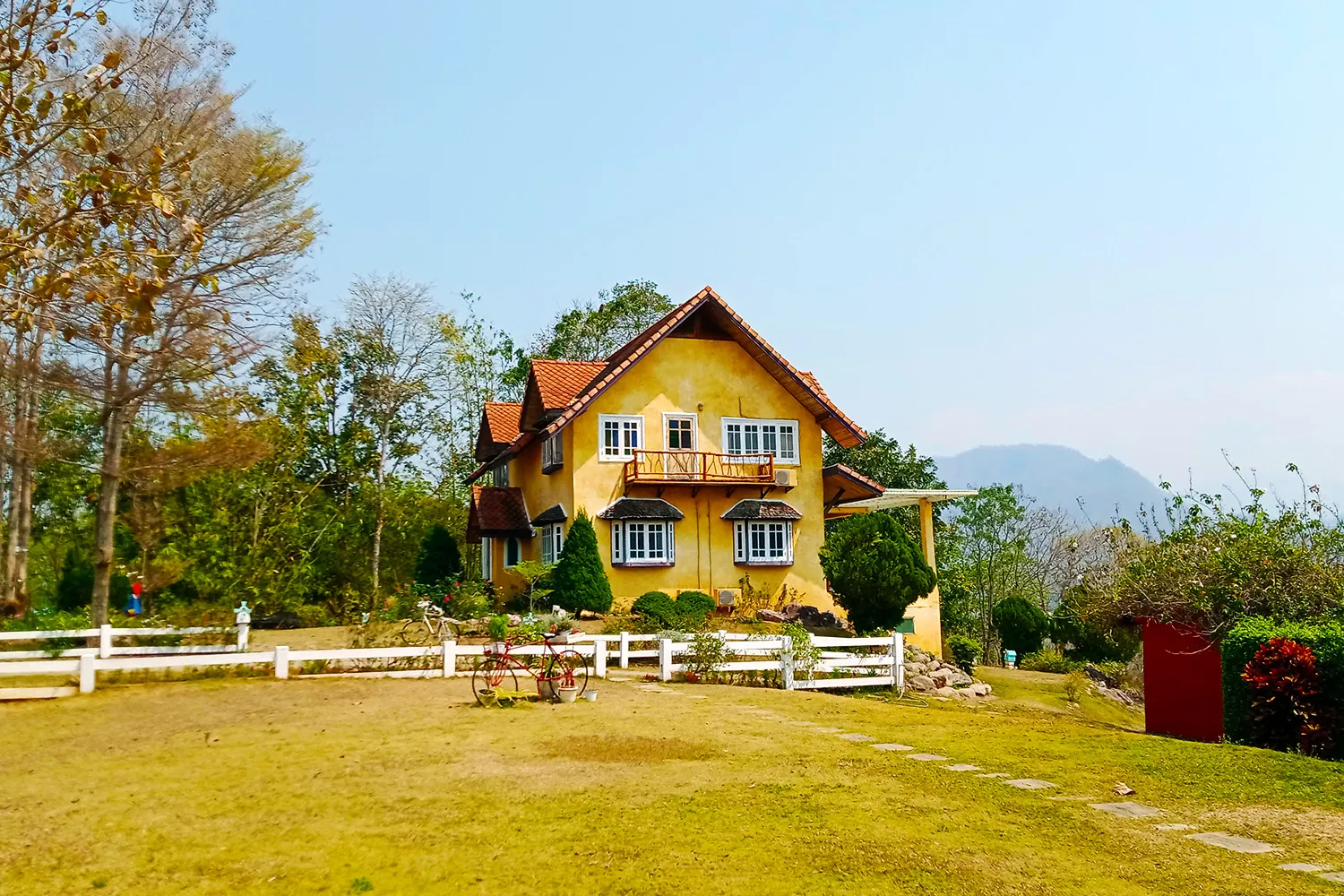
Pai Canyon (Kong Lan):
Pai Canyon, renowned by the moniker Kong Lan, graces the landscape within Rong Yang Village, nestled in the heart of Mae Hi Subdistrict, Pai District. This natural wonder, born from the intricate dance of high-altitude soil subsidence and the ceaseless caress of wind and rain, has sculpted deep crevices reminiscent of cliffs. Some sections take on the form of sprawling, sinuous ridges, weaving together to cover an expanse exceeding 3 acres. The canvas surrounding Pai Canyon paints a picture of mixed deciduous forests, a tapestry rich with an assortment of plant life. Winding like an artist’s brushstroke along the crests of ridges, the trails that trace Pai Canyon’s contours are both narrow and precipitous. They offer a unique vantage point, showcasing lush forests and unfathomable chasms that unravel below. Yet, nature’s artistry doesn’t end there. The pinnacle of Pai Canyon reveals a breathtaking tableau. Here, visitors are gifted with vistas that stretch beyond the immediate expanse, allowing them to gaze upon the quaint villages and cultivated fields of the villagers below. This captivating sight is framed by the majestic backdrop of towering mountains, their peaks punctuating the horizon. It is in this elevated realm that another spectacle unveils itself – a stunning sunset that casts a warm, golden glow across the Pai District. This vantage point, perched atop Pai Canyon, has earned its reputation as a veritable sanctuary for witnessing the sun’s descent, an offering of beauty that adds another layer of allure to this remarkable locale.
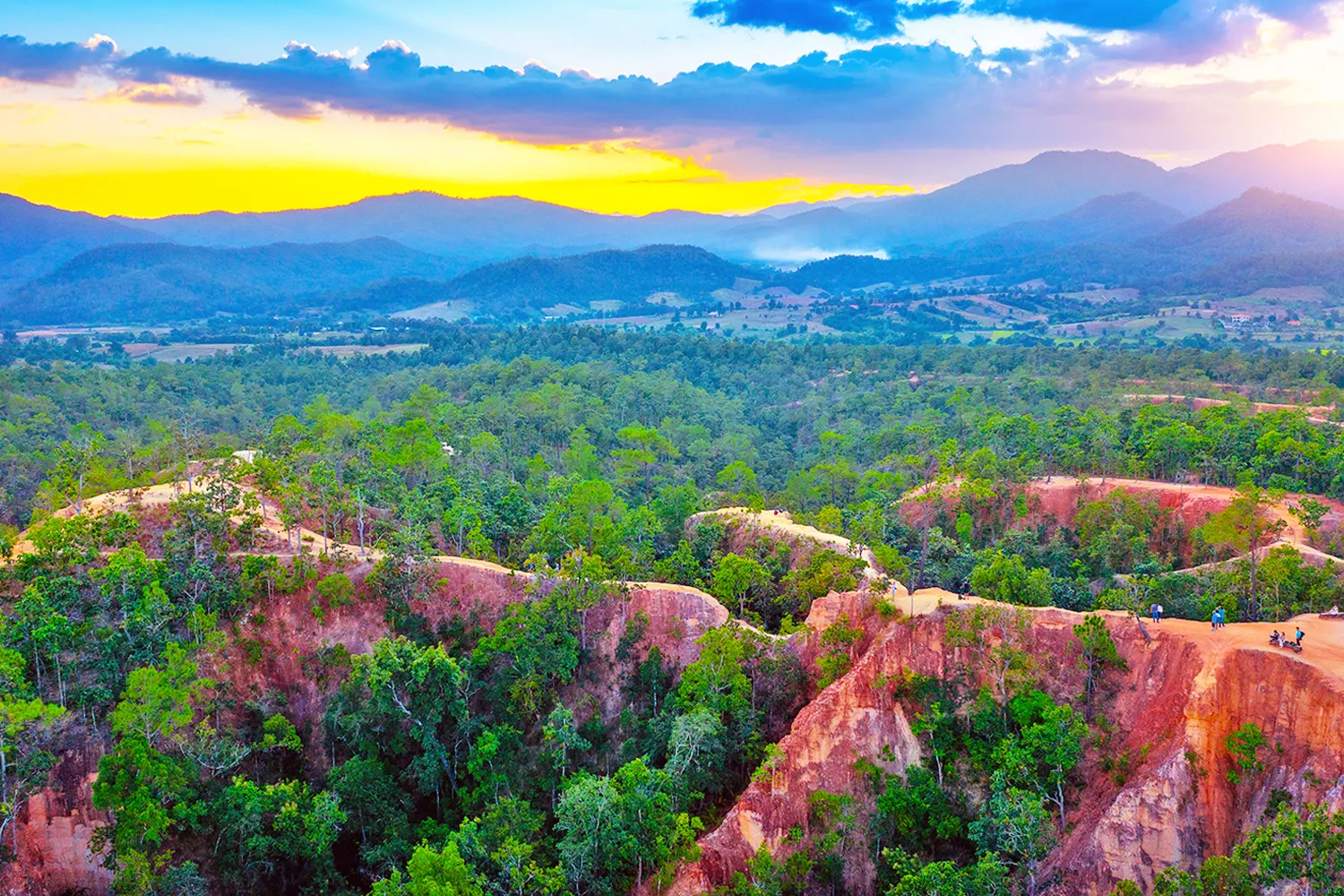
Khokuso Bamboo Bridge:
Stretching gracefully across the expanse of a picturesque rice field, the bridge spans approximately 1.5 meters in width and extends a generous 800 meters in length. This architectural marvel serves as a vital conduit, seamlessly connecting the revered Huay Khai Kiri temple with the quaint Ban Phaem Bok village. The bridge’s inception was conceived with a purpose both noble and practical: to fashion a dedicated thoroughfare for the morning alms rounds undertaken by monks and novices. Additionally, it facilitates the ease of travel for villagers, a boon that proves particularly invaluable during the inclement embrace of the rainy season. As one treads along this elevated path, flanked by the verdant tapestry of rice fields, a symphony of captivating vistas unfurls along its entirety. The journey becomes an immersion into the realm of natural beauty, a picturesque panorama that extends along both sides of the bridge. These vistas encapsulate the essence of tranquility and enchantment, offering a visual respite that complements the bridge’s functional purpose. In essence, this bridge transcends mere construction; it is a testament to human ingenuity harnessed to enhance both spiritual practices and daily life. As it gracefully traverses the rice field, linking two important locales, it also weaves together the rich fabric of nature’s beauty. Every step upon this bridge is an invitation to partake in a symphony of sight and purpose, a journey that is as soul-enriching as it is visually captivating.
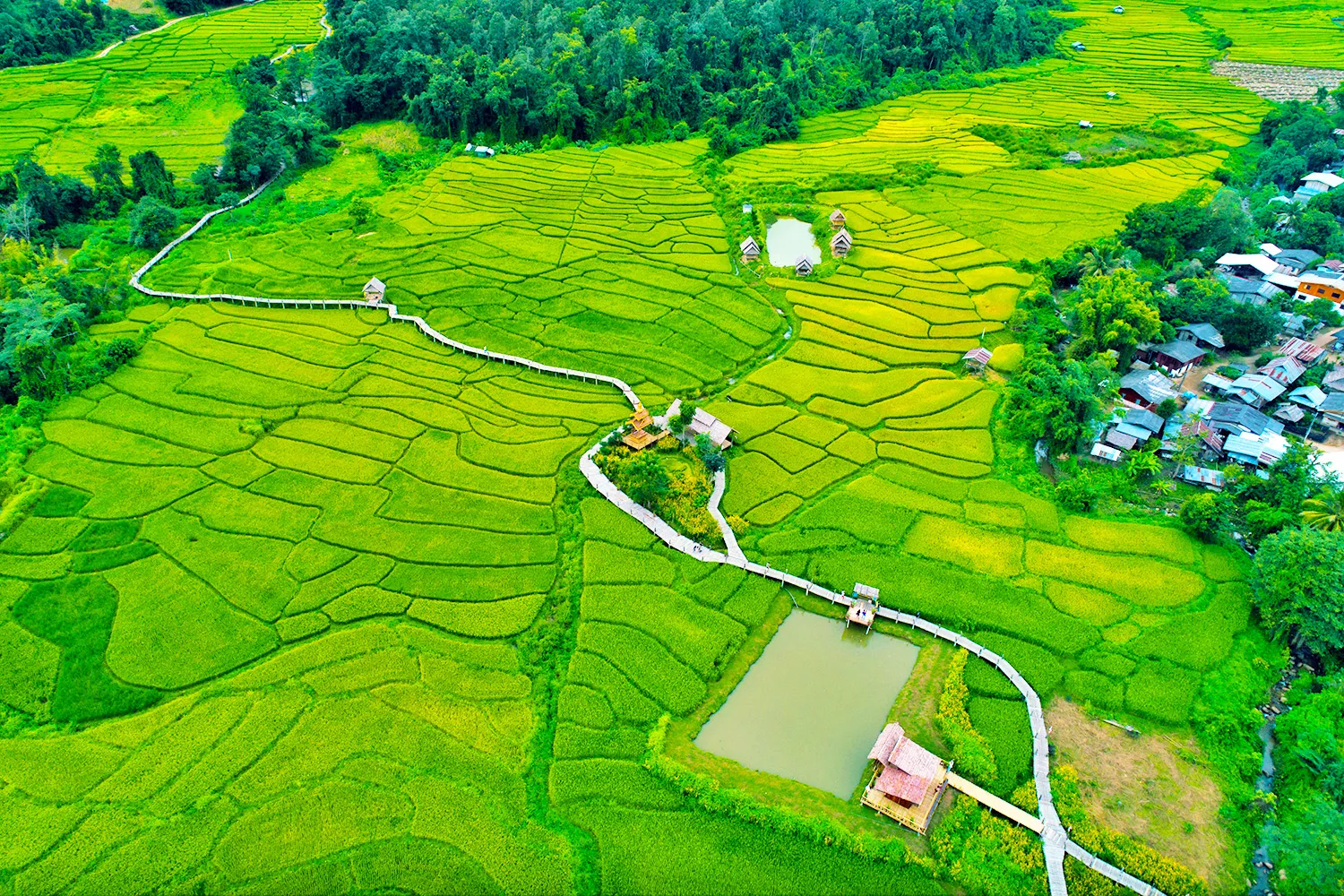
Land Split:
The Land Split in Pai stands as a striking geological marvel, a testament to the Earth’s dynamic forces. This intriguing phenomenon emerged as a series of significant fissures, spanning the years from 2008 to 2011, etching their presence onto private land. Each fracture exhibits a unique combination of depth, width, and length, adding to the complexity of this geological display. This very land, once dedicated to agricultural pursuits by its owner, a diligent farmer, underwent a transformation with the advent of these successive fissures. The land’s prior role as a cultivator’s haven was irrevocably altered by nature’s hand, rendering it unsuitable for its original purpose. Accompanying the whispers of this natural occurrence was a surge of curious tourists drawn to witness the spectacle firsthand. Responding to this newfound interest, the land’s owner seized the opportunity, opening its grounds to eager visitors. The Land Split, once a site of agricultural toil, metamorphosed into a thriving tourist attraction. Today, this enigmatic rift stands as a prominent draw within Pai District, an awe-inspiring testament to the Earth’s intricate processes. With the passage of time, the Land Split has solidified its status as a celebrated landmark, annually beckoning countless tourists to its captivating embrace. The intrigue sparked by this geological enigma continues to inspire visitors to journey to its location, igniting a sense of wonder and a deeper connection to the unfathomable forces shaping our world.
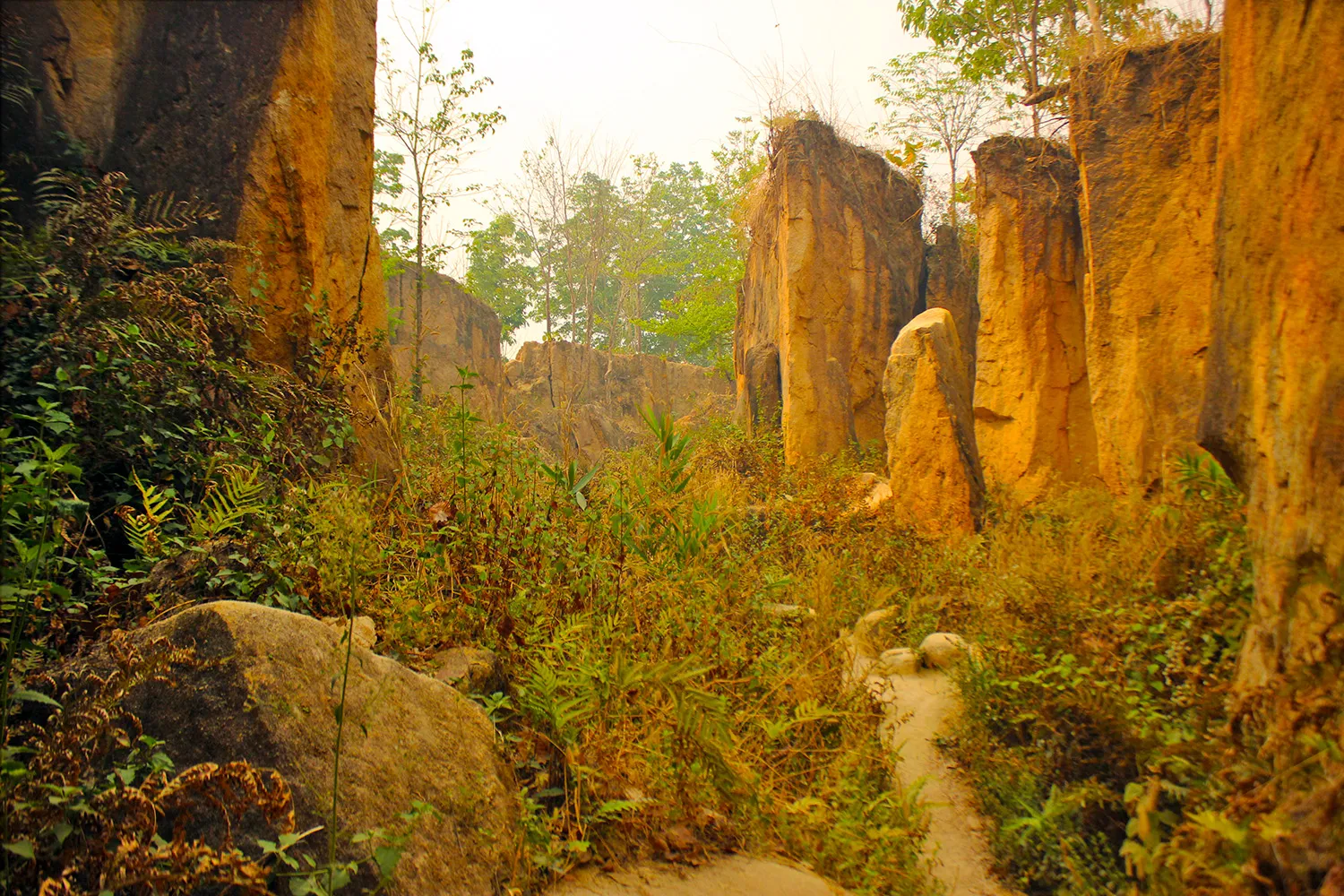
Suntichon Village:
Nestled just five kilometers away from the bustling heart of Pai City, Suntichon Village emerges as a captivating enclave with roots tracing back to Yunnan, China. This village, borne from a historic exodus from its distant homeland, encapsulates a treasure trove of Yunnan Chinese culture and heritage. Stepping into Suntichon Village offers travelers a remarkable journey into a world where conservative traditions and age-old customs flourish. From the distinct language spoken to the intricate attire worn by the villagers, the essence of Yunnan’s cultural tapestry is vividly on display. However, it is the delectable Yunnan cuisine that stands as a true highlight, enchanting the palates of visitors and garnering admiration in abundance. Wandering through the village’s inviting streets, one encounters the Chinese-Yunnan Center, a hub that celebrates and shares the rich heritage of this community. This vibrant space serves as a bridge, connecting curious travelers to the village’s essence through insightful exhibitions and immersive experiences. For those seeking to capture a piece of this cultural encounter, souvenir shops offer an array of treasures that echo the spirit of Suntichon.
The culinary journey continues with a tantalizing array of Chinese-Yunnan delicacies. Within the village’s embrace, visitors are treated to a gastronomic odyssey that delights the taste buds and leaves a lasting impression. From hearty dishes that evoke nostalgia to tantalizing flavors that transport diners to Yunnan’s verdant landscapes, each bite is an homage to the culinary mastery of the region. In summary, Suntichon Village stands as a captivating haven, a Yunnan Chinese village transplanted across borders and time. Here, the pages of history unfurl through the villagers’ language, dress, and cuisine, inviting travelers to partake in a cultural immersion like no other. With its Chinese-Yunnan Center, artisanal souvenirs, and an abundance of delectable offerings, Suntichon Village extends a warm welcome to all who seek to uncover the hidden gems of Yunnan’s vibrant legacy, nestled in the heart of Pai.
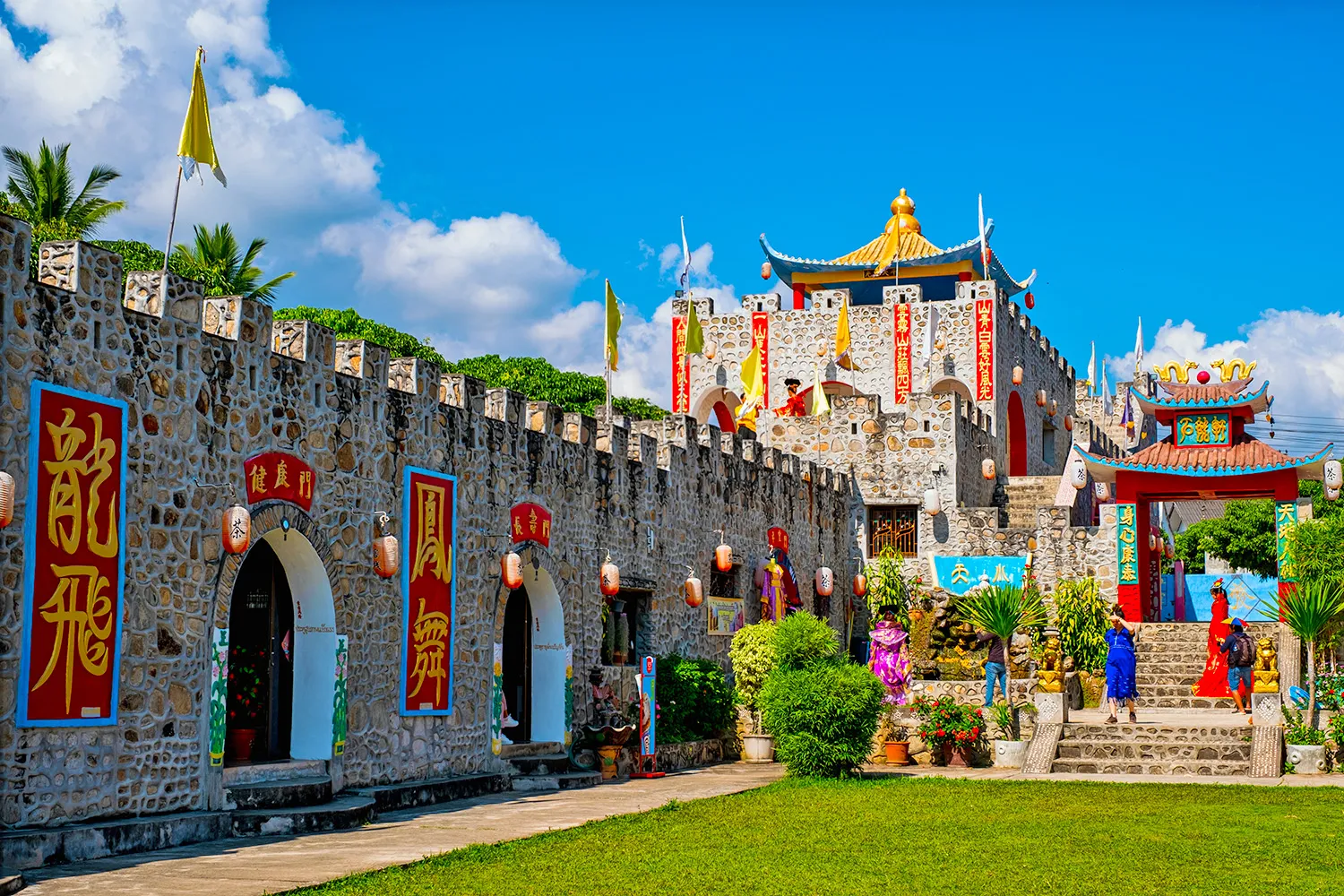
Yun Lai Viewpoint:
Perched gracefully within Santichon Village, Wiangtai Sub-district, just 5 kilometers distant from the heart of Pai District, the Yun Lai viewpoint unveils a breathtaking panorama that stretches far and wide. Here, nature’s grandeur converges with human endeavor, offering tourists a vantage point that encapsulates the majesty of Pai City’s enveloping mountains and fertile farmlands. As the seasons unfurl their unique tapestries, the Yun Lai viewpoint remains a beacon of awe. In the rainy season and the embrace of winter’s chill, early morning visitors are treated to a sight that transcends imagination – an ethereal sea of pristine white mist. This spectacle, both impressive and unforgettable, unfolds before the eyes of each fortunate observer, etching a memory that endures. The Yun Lai viewpoint is not merely a feast for the eyes, but a haven replete with offerings for the wandering traveler. Accommodation options stand ready to embrace visitors seeking to prolong their communion with nature. For those with a penchant for outdoor escapades, space for tents awaits, promising a night beneath the stars. Additionally, an array of shops and restaurants caters to diverse tastes, ensuring that every craving is met with culinary satisfaction. Embarking on a journey to Yun Lai viewpoint requires a strategic approach. Travelers begin by making their way to Santichon Village from Pai City, where they find a sanctuary for their vehicles. The road leading from the village to the viewpoint is characterized by its narrowness and incline, necessitating a prudent choice. In this endeavor, visitors enlist the aid of a vehicle from Santichon Village, a shared venture that accommodates up to 10 individuals and is availed at a cost of 300 Thai baht per vehicle. Upon reaching the viewpoint, an admission fee of 20 Thai baht per person provides access to the stunning tableau that awaits.
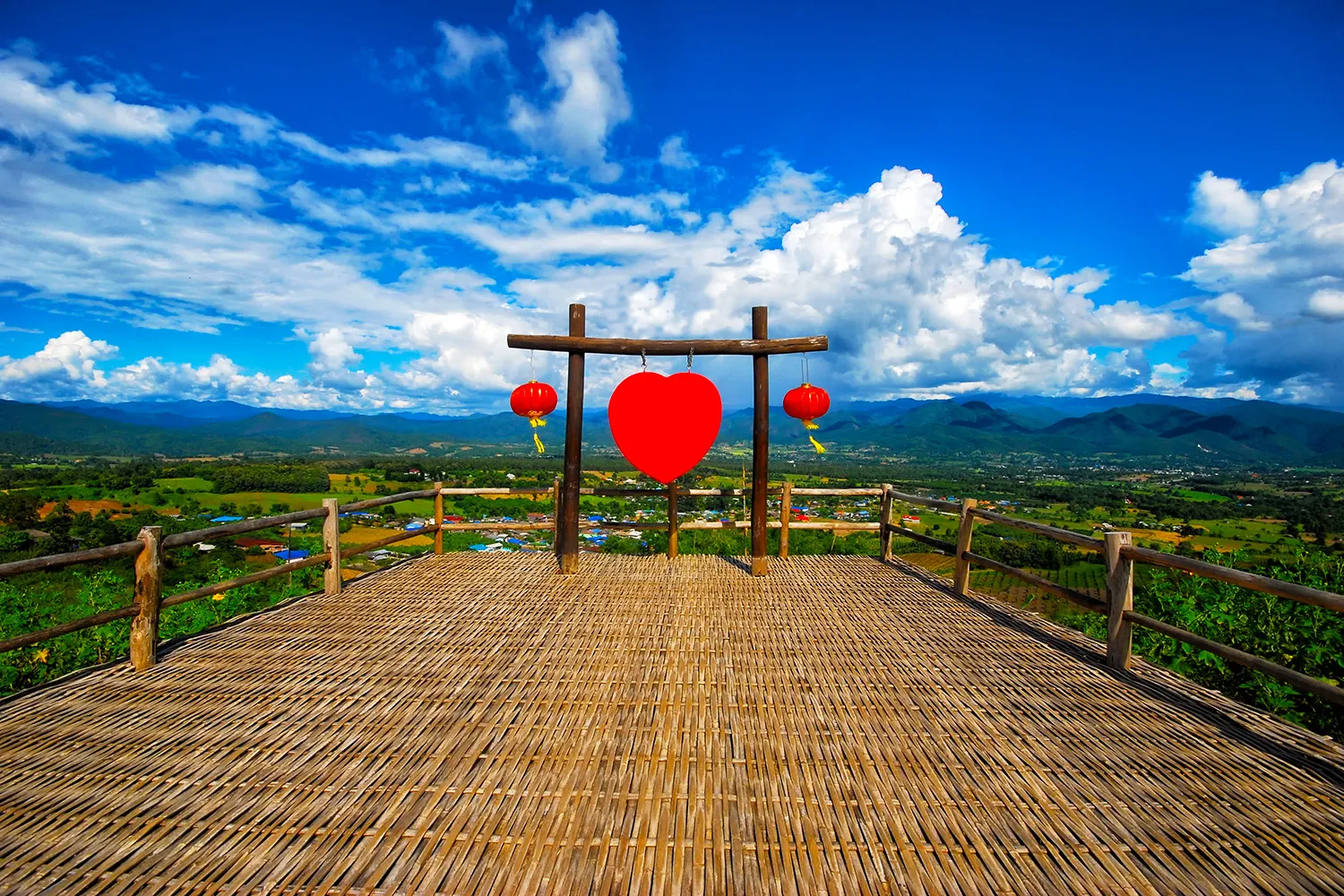
Mae Yen Waterfall:
Nestled deep within the heart of a secluded, dense forest, the Mae Yen Waterfall beckons as a hidden treasure awaiting discovery. Cascading in three stages, each tier unveils its own unique splendor, weaving together a symphony of beauty that has earned it the esteemed title of the most captivating waterfall in Pai. The embrace of Mae Yen Waterfall extends beyond its aquatic allure, encompassing a landscape adorned with a verdant canopy. The tranquil haven is cocooned within a tapestry of diverse plant life, an orchestra of nature that enhances the waterfall’s serene ambiance. Venturing to Mae Yen Waterfall entails an exploration that ventures beyond the ordinary. Approximately seven kilometers distant from Pai town, this pristine gem can only be accessed on foot. Thus, it stands as a sanctuary perfectly suited for those with a penchant for trekking and a penchant for embracing the journey itself. The trek to the waterfall’s embrace is an experience in its own right, stretching over a considerable distance and demanding 4-5 hours for a round trip. This journey is best suited for travelers who relish the thrill of discovery and have the luxury of time to immerse themselves in the unfolding wonders of the forested path. While Mae Yen Waterfall beckons year-round, there is an optimal time to savor its splendor. The winter season, spanning from November to May, offers the ideal backdrop for a transformative encounter. During this time, the cascading waters and the surrounding scenery harmonize in breathtaking synergy. In contrast, the rainy season unveils a different aspect, one that should be approached with caution. The risk of flash floods necessitates a thoughtful decision to abstain from visiting during these months.
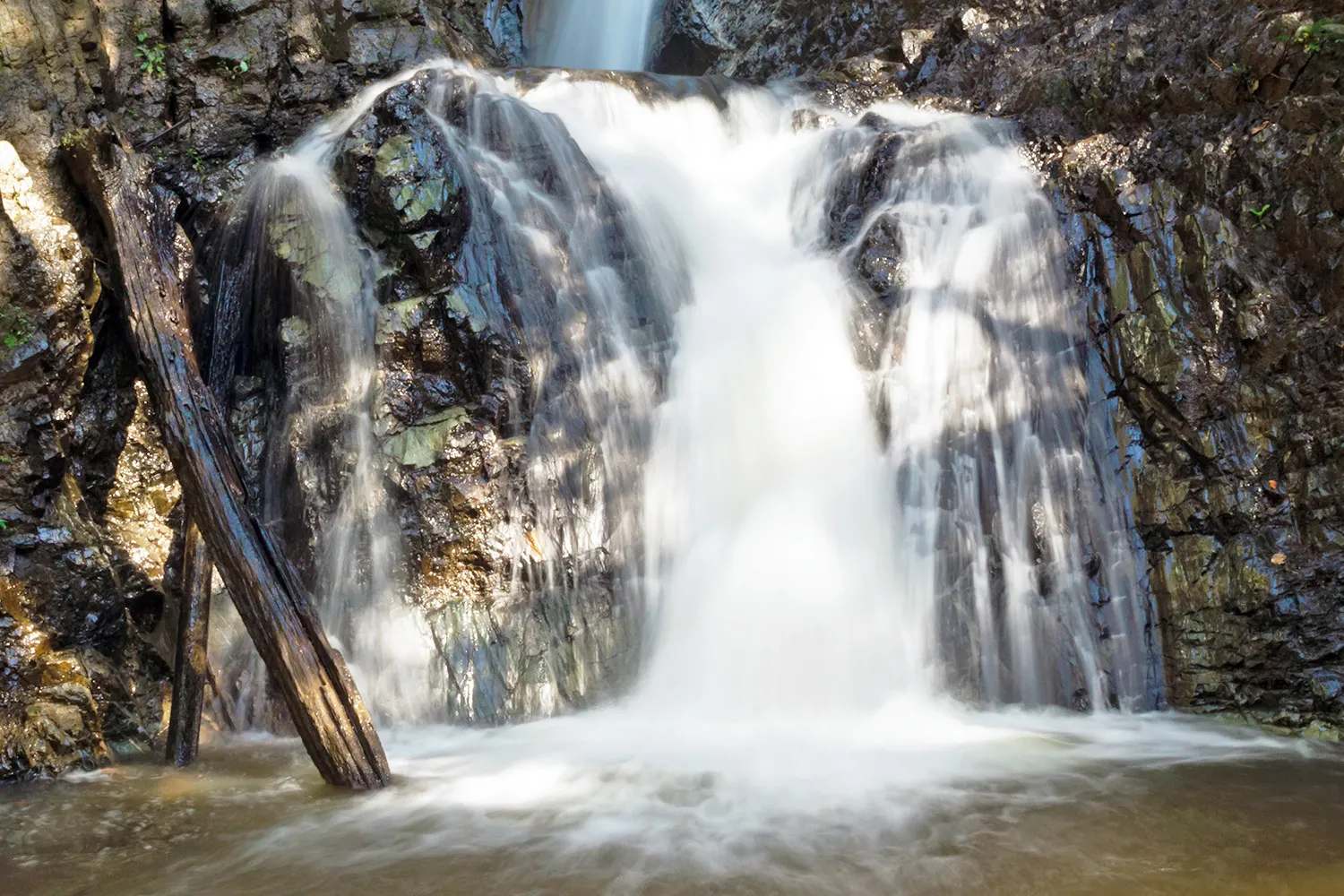
Mor Pang Waterfall:
Mor Pang Waterfall graces the landscape in a triumphant three-stage cascade, an embodiment of nature’s artistic prowess. Its allure stands unabashed, rivaling the splendor of other renowned waterfalls. Situated at an approximate distance of 8 kilometers from the district, Mor Pang Waterfall boasts an aesthetic that is both unique and captivating. The waterfall’s charm extends beyond its liquid descent, encompassing the very stones that cradle the flowing waters. These carefully arranged pieces of stone contribute to the waterfall’s captivating beauty, creating a picturesque scene that unfurls before the beholder. The surrounding environment embraces the waterfall’s serenity, a symphony of grand and modest trees that evoke a sense of calm and tranquility. This idyllic ambiance offers a haven for those who seek respite, a private sanctuary where one can bask in solitude. Beyond the waterfall’s embrace lies a realm rich in cultural exploration. Nearby, nestled within the landscape, Lahu hill tribe villages beckon with the promise of discovery. A visit to these villages opens a window into the lives and customs of the local inhabitants, offering a firsthand encounter with their culture and lifestyle. This immersive experience adds depth to the journey, enriching it with an understanding of the communities that call this land home.
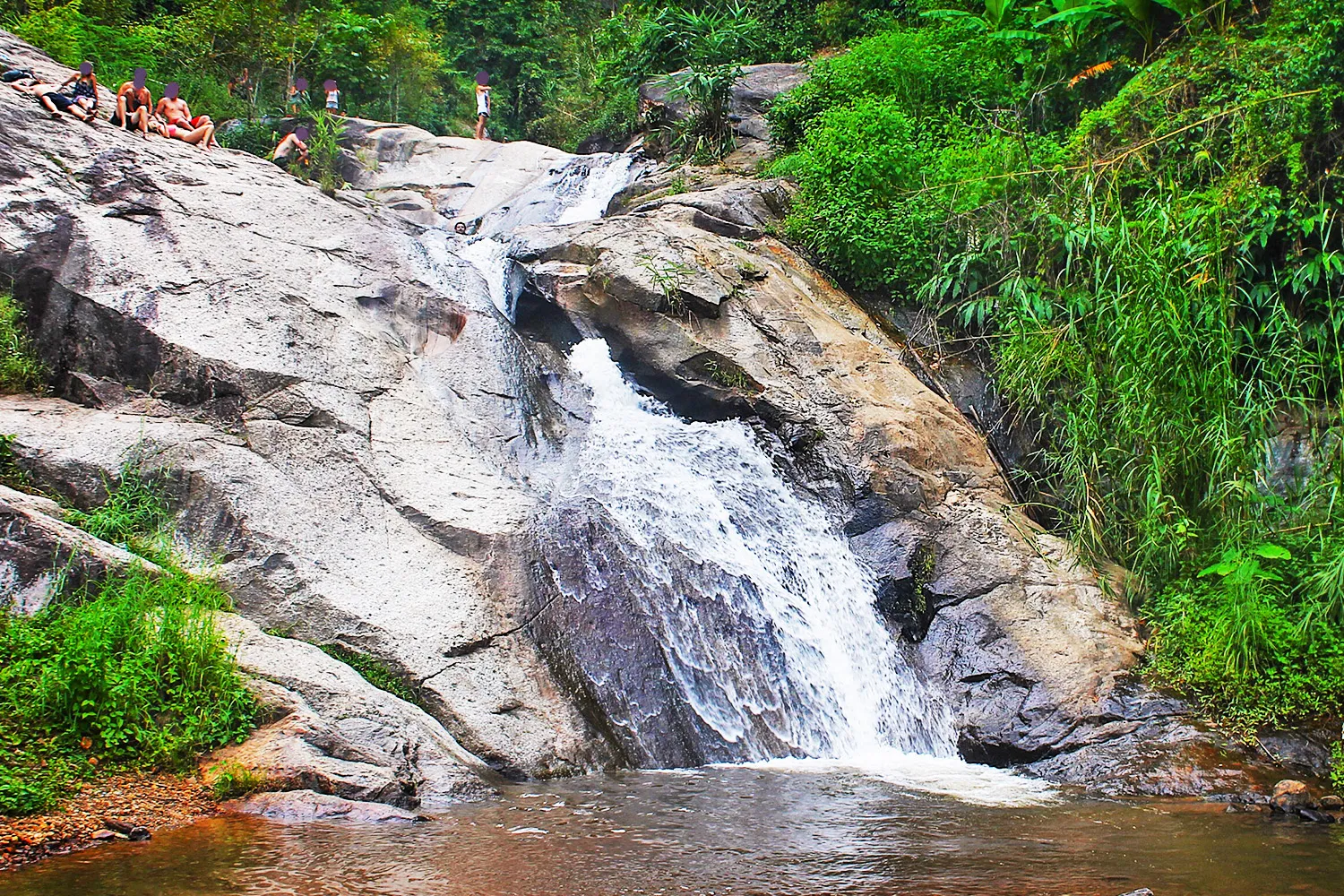
Tha Pai Hot Spring:
Nestled within the embrace of Mae Hee sub-district, a mere eight kilometers from the charming Pai town, the Tha Pai Hot Spring emerges as a captivating oasis. Here, visitors are embraced by the splendor of Pong Nam Ron, a natural hot spring that offers a captivating blend of beauty and therapeutic warmth. Pong Nam Ron Tha Pai Hot Spring, in all its glory, presents a stunning spectacle as it springs forth from the depths of the Earth’s embrace. The water, heated to a scorching 80°C, casts ethereal plumes of steam and smoke that dance in the air, bestowing an otherworldly aura upon the surroundings. En route, pockets of delight await, manifesting as inviting pools that beckon tourists to immerse themselves in the soothing waters. Beneath the dappled shade of towering trees, a sense of cool serenity pervades the air, setting the stage for moments of relaxation and contemplation. This haven, enveloped in nature’s embrace, has earned its rightful place among the region’s must-see destinations. As visitors traverse this picturesque landscape, they are offered a harmonious blend of tranquility and spectacle. Beyond a mere daytime escapade, Tha Pai Hot Spring extends an invitation to linger longer. Adventurous souls are welcome to pitch tents and savor an overnight sojourn beneath the stars. This unique opportunity to commune with nature throughout the night adds an extra layer of enchantment to the experience.
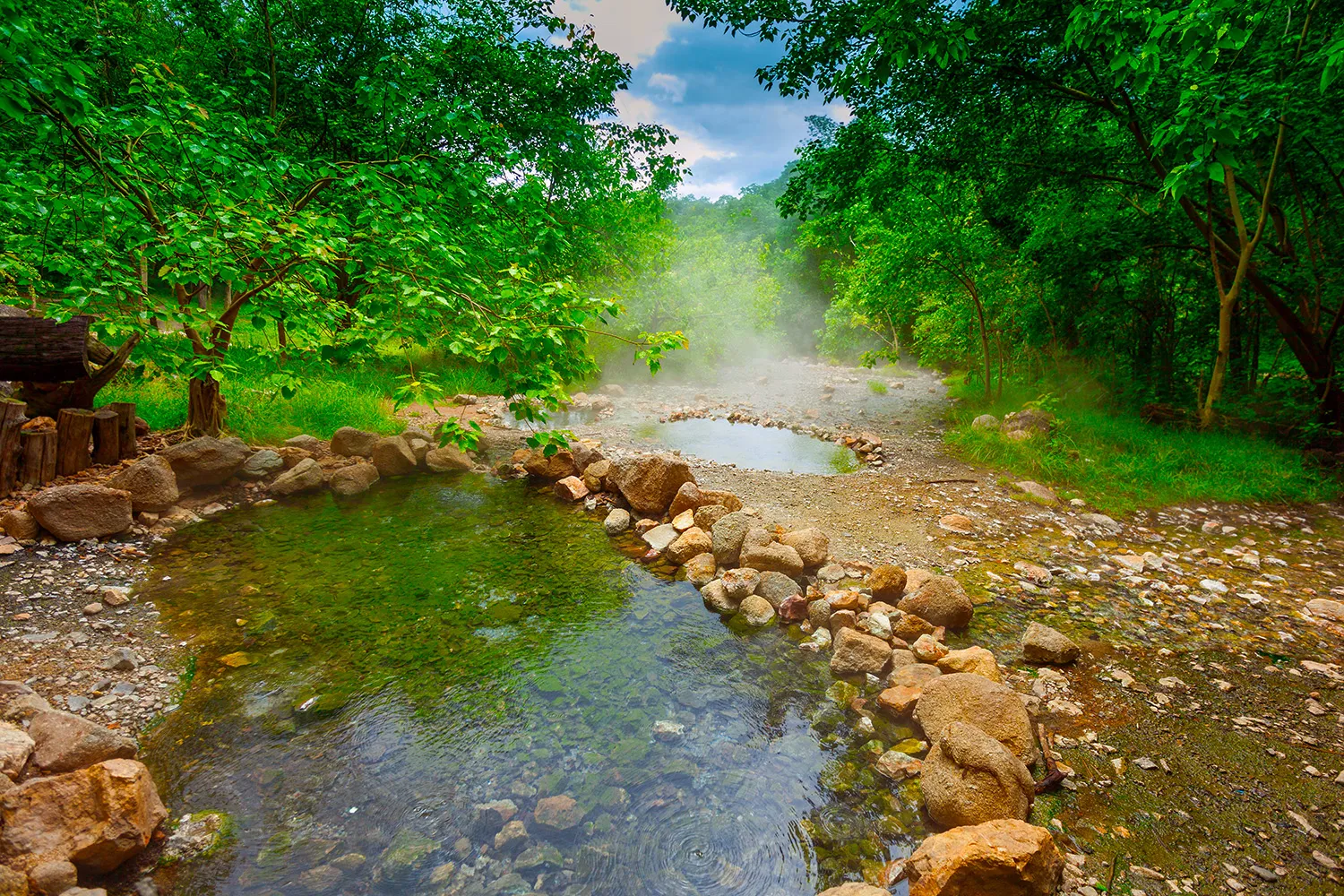
Sai Ngam Hot Spring:
Nestled within the enchanting embrace of the Sai Ngam forest reserve, the Sai Ngam Hot Spring emerges as a hidden jewel waiting to be uncovered. Situated in Sai Ngam village, this natural wonder springs forth with water that carries the gift of natural warmth. Enveloped by verdant foliage, this tranquil haven presents a unique characteristic—a series of petite pools, arranged in a descending order akin to water droplets. Unlike other hot springs that gush upwards, Sai Ngam Hot Spring delights in a more subtle spectacle. The water gracefully ascends from the depths below, forming pools that mirror the cascading nature of water droplets. This intriguing feature, coupled with the spring’s natural warmth, invites visitors to partake in a truly one-of-a-kind experience. The crystal-clear, emerald green waters that grace these pools reveal the secrets of the terrain beneath. With a shallowness that allows glimpses of rocks and sands, Sai Ngam Hot Spring offers an intimate connection to the earth’s depths. This transparency adds a touch of allure, making the spring an immersive encounter with nature’s beauty. In the vibrant tapestry of Pai District’s attractions, Sai Ngam Hot Spring has emerged as a sought-after gem. Travelers from near and far are drawn to its soothing waters, finding respite and relaxation within the ambiance of this natural thermal oasis. As the warmth envelops and the surroundings inspire, Sai Ngam Hot Spring beckons visitors to unwind and rejuvenate in the company of its tranquil waters—a symphony of nature’s elegance and serenity.
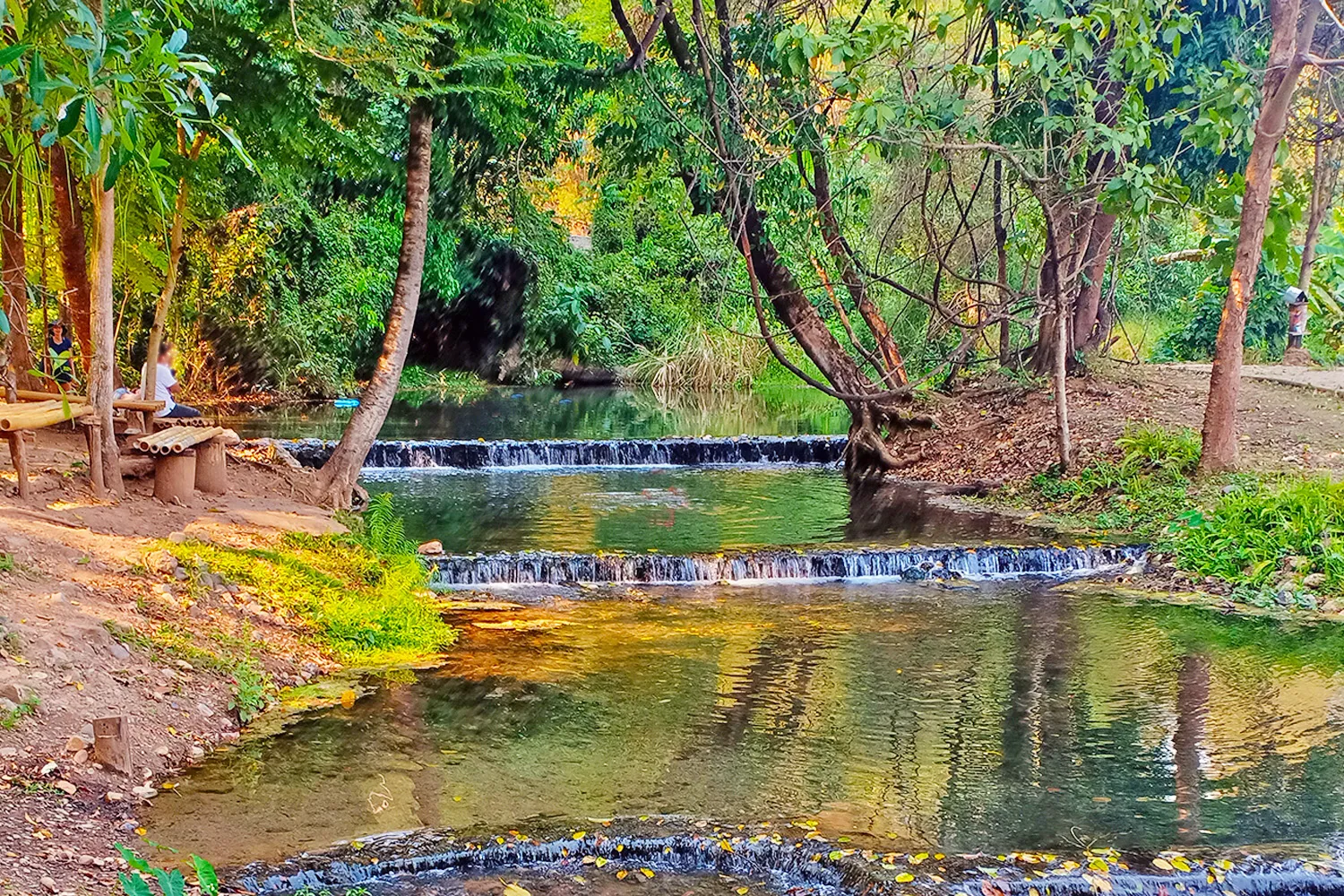
Muang Pang Hot Spring:
Nestled within the picturesque expanse of Pai district, Muang Pang Hot Spring emerges as a captivating jewel among the region’s thermal wonders. Situated within the Baan Muang Pang vicinity, this natural oasis stands 28 kilometers removed from the heart of Pai district, offering a tranquil escape from the bustle of everyday life. Muang Pang Hot Spring unveils its splendor in a grand display of warmth and beauty. With temperatures soaring to an impressive 95°C, the spring’s effervescent waters cascade gracefully from elevated terrain to lower ground, creating a mesmerizing dance along the contours of both sizable and diminutive rock formations. This breathtaking sight is complemented by the panoramic vistas that encircle the area, inviting visitors to indulge in a sensory immersion amidst nature’s embrace. As the sun illuminates the landscape, Muang Pang Hot Spring becomes a canvas of charm and allure. Travelers are invited to relish in the juxtaposition of the spring’s fervent waters against the serene backdrop of the surrounding hills. This tranquil setting provides ample opportunity for visitors to fully absorb the spring’s captivating presence, allowing its beauty to wash over them in a symphony of sensory delight.
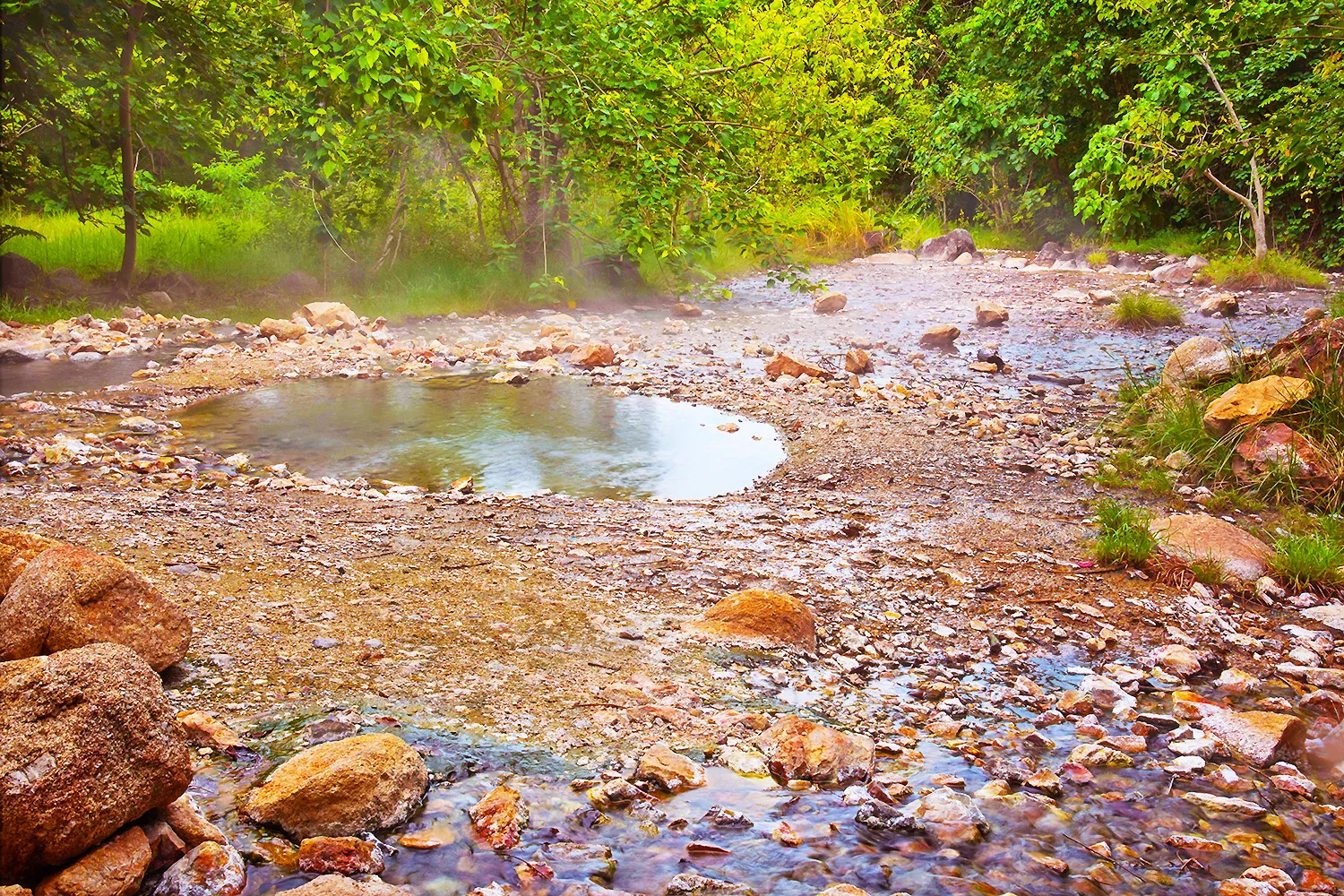
Tha Pai Memorial Bridge:
The Tha Pai Memorial Bridge stands as a solemn testament to a pivotal era in history. Constructed during the throes of the Second World War, a time when Japan held considerable sway over Thailand, the bridge played a significant role in facilitating the movement of troops and weaponry into Myanmar. This strategic purpose mirrored that of the Kwai River Bridge, showcasing the bridge’s wartime significance. While the bridge once served as a vital conduit for local inhabitants, its importance has evolved over time. In the present day, a modern and standardized bridge has supplanted its functional role. Nevertheless, the Tha Pai Memorial Bridge endures as a poignant relic of history, etching its memory into the landscape. As the years have passed, the bridge has undergone the wear and tear of time, a testament to the passage of history. Despite its dilapidated state, the Tha Pai Memorial Bridge has found a new purpose as a poignant backdrop for tourists seeking to capture a memory of their journey through Pai district. A testament to its significance, the bridge has become a favored spot for photography, allowing visitors to immortalize their experience within the frame of its weathered timbers. Today, a sense of regret mingles with the reverence that the Tha Pai Memorial Bridge commands. Its decay has rendered it unsuitable for functional use, marking the end of an era. However, its enduring presence serves as a poignant reminder of the sacrifices made during wartime and the indelible impact of history on the landscapes we traverse.
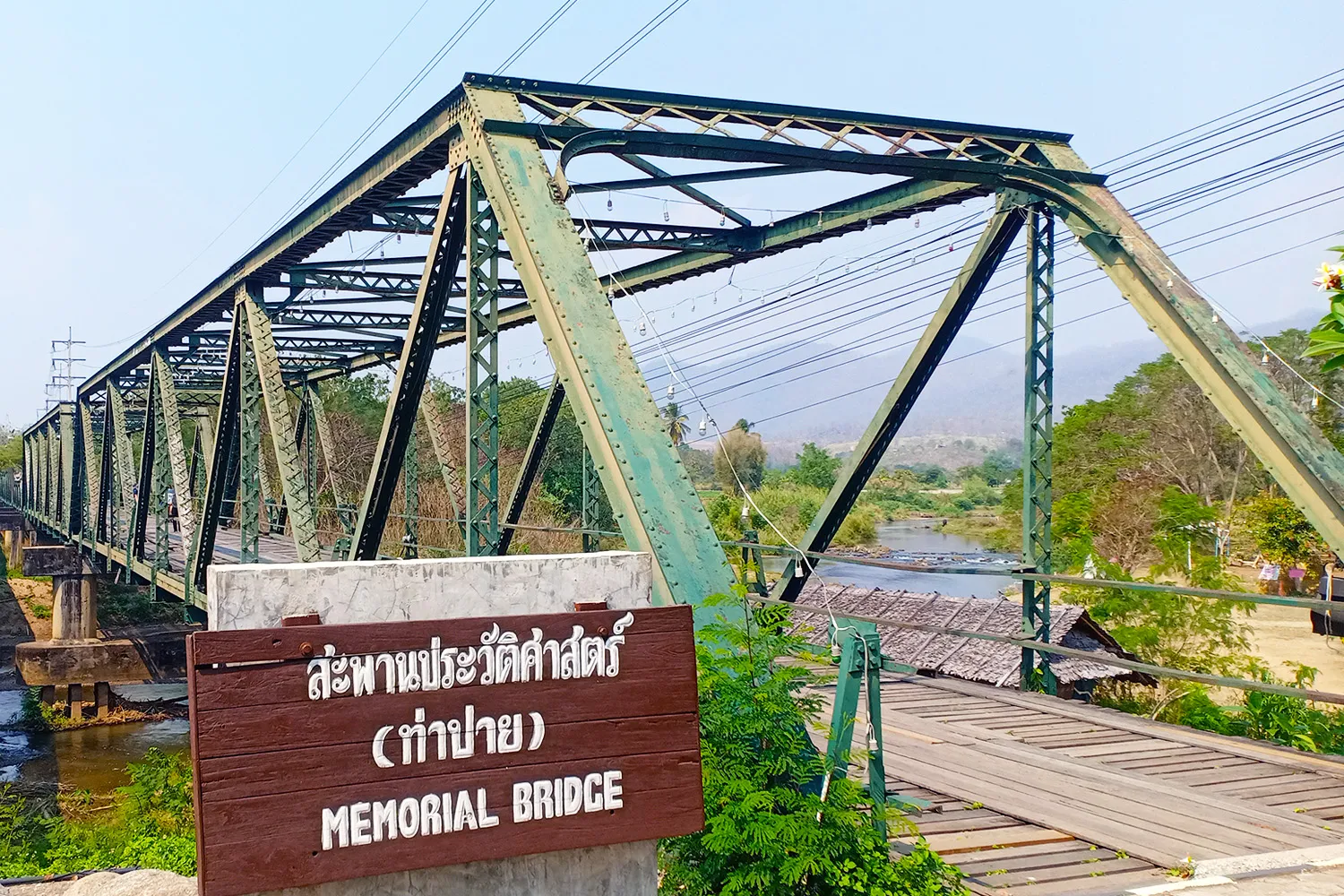
Pai Walking Street:
As the night descends upon Pai city, a captivating transformation unfurls along its main road. The thoroughfare, typically reserved for vehicular traffic, undergoes a charming metamorphosis as it is closed off to cars, yielding to the enchantment of Pai Walking Street. This nightly spectacle breathes life into the city, a bustling gathering of vendors and visitors alike. The vibrant tapestry of Pai’s identity is artfully woven into the fabric of this pedestrian haven. A cornucopia of souvenirs beckon from stalls that sprawl across the pavement, proudly showcasing an array of local treasures. From delicate ornaments that capture the essence of Pai’s spirit to an assortment of verdant vegetation and succulent fruits, the offerings are a reflection of Pai’s character. At the heart of this bustling hub lies a small stall, the humble genesis of Pai Walking Street. Here, the people of Pai district proudly present their wares, alongside an assortment of local products and the intricate handicrafts of hill tribes. The transformation is a remarkable sight as stalls unfurl, with many finding their place directly on the ground, illuminated by the warm glow of streetlights. The ambiance occasionally embraces the soft embrace of candlelight, casting a dreamy aura over the scene. Pai Walking Street is an exercise in simplicity and charm, with a modest number of shops and stalls lining its sides. The meandering path is punctuated by long lines of flickering lights, imbuing the atmosphere with a sense of comfort and tranquility. It is an ambiance that encourages visitors to let loose, to revel in the moment and delight in their emotions. The allure of this setting has propelled Pai Walking Street to fame, capturing the hearts of those who seek an immersive and delightful experience.
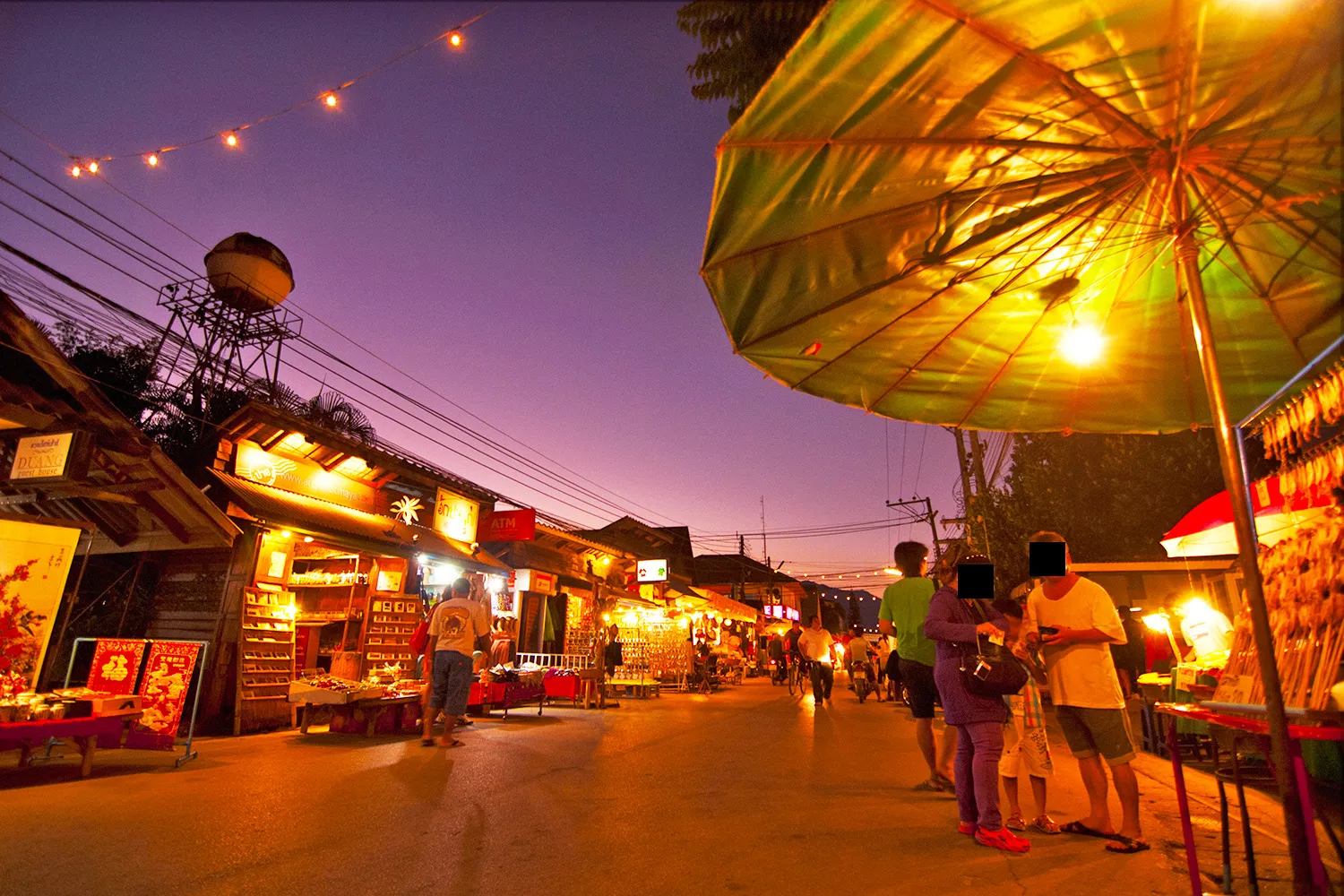
Wat Sri Don Chai Temple:
Wat Sri Don Chai, an esteemed temple steeped in historical significance, graces the landscape within Wiang Nuea Sub-district, Pai District. As a relic of the past, it stands as the first temple to have graced Pai, its presence echoing through the annals of time for hundreds of years. Within the temple’s sacred grounds, an ubosot stands resplendent, embodying a harmonious fusion of Burmese and Lanna artistry. Every intricacy of its construction is reminiscent of a masterful literary painting, exuding beauty and cultural richness. The ubosot serves as a testament to the region’s artistic heritage, preserving the essence of the past for present generations to marvel at. Deep within the sanctum of the ubosot resides Phra Phuttha Sihing, lovingly referred to as Phra Singh Pai. This revered Buddha image is an exquisite representation of Chiang Saen art, a relic that dates back to the year 1478. The image’s journey to Pai was an auspicious one, traveling from Nopburi Srinakhon Ping Chiang Mai to find its cherished abode within the temple’s sacred embrace. As the lively celebration of Songkran, the Thai New Year, ushers in its joyous atmosphere, Wat Sri Don Chai comes alive with a vibrant parade ceremony. During this momentous occasion, Phra Singh Pai takes center stage, as the faithful gather to pay their respects, bathe the image, and seek blessings for the year ahead. This time-honored tradition is a testimony to the enduring spirituality and cultural heritage that thrives within the temple’s hallowed walls.
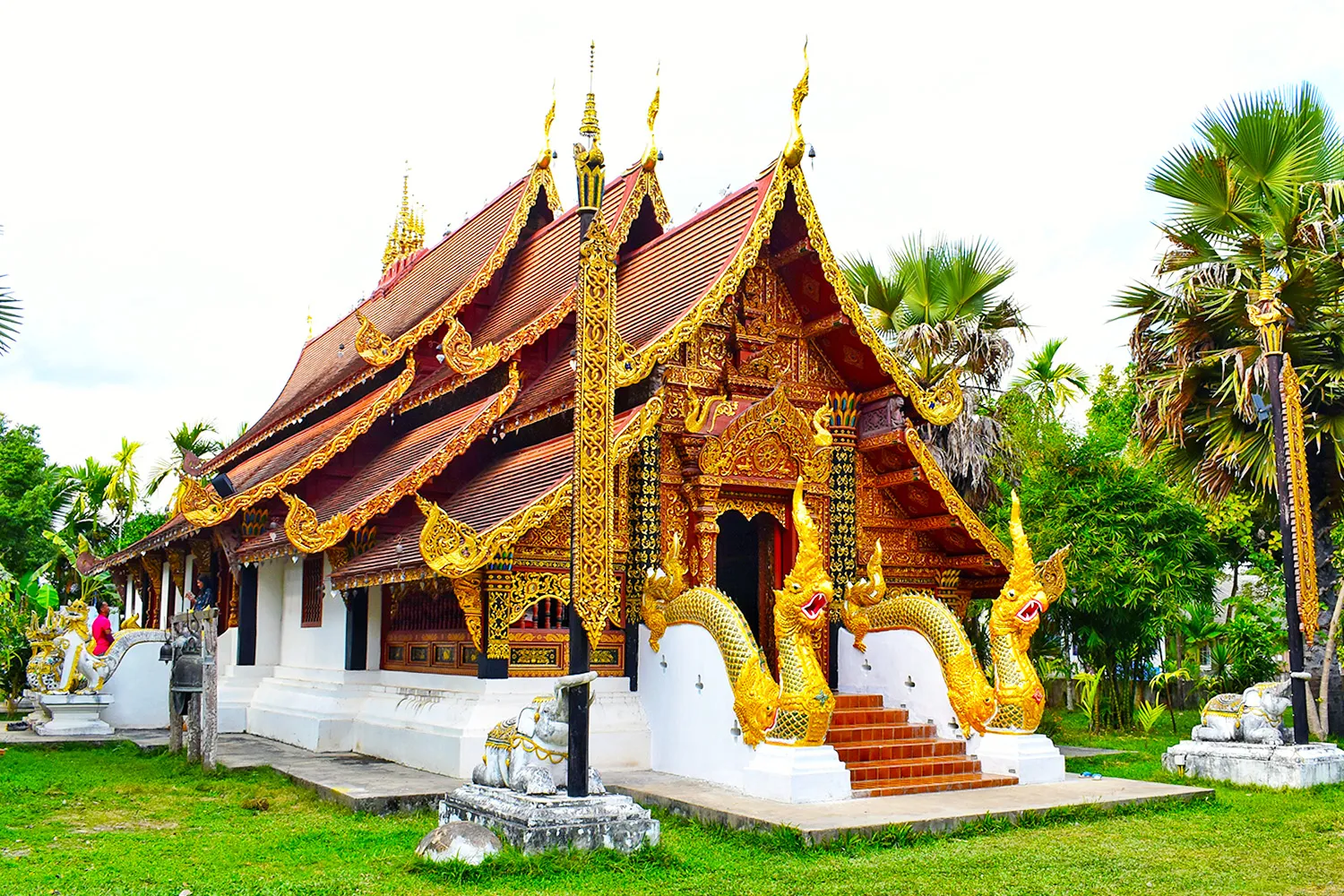
Wat Nam Hu Temple:
Nestled within the serene embrace of Wiang Tai sub-district, a mere 3 kilometers from Pai Town, the captivating Wat Nam Hu Temple stands as a beacon of spirituality and artistry. This sacred haven is distinguished by its revered centerpiece, the illustrious Pra Aun Muang, a bronze Buddha statue with dimensions of 28 inches in width and 30 inches in height. A remarkable feature adorns this statue, where its crown can be delicately opened and closed, while perpetually cradling a pool of water. Though the exact date of its creation remains shrouded in the mists of time, local lore intertwines Wat Nam Hu Temple with the legacy of Phra Naresuan the Great. Believed to have been constructed during his reign, this masterpiece was purportedly crafted as a gift for his sister, Phra Supan Kalaya. This rich history imbues the temple and its treasured statue with a profound sense of heritage and significance. Within the tranquil sanctuary of Wat Nam Hu Temple, the faithful and curious alike are welcomed to partake in worship and reflection. The temple’s doors stand open daily, inviting visitors to connect with the spiritual essence that permeates this sacred space. As the gentle breezes rustle through the foliage and the temple’s aura of tranquility envelops all who enter, a sense of reverence and awe unfolds.
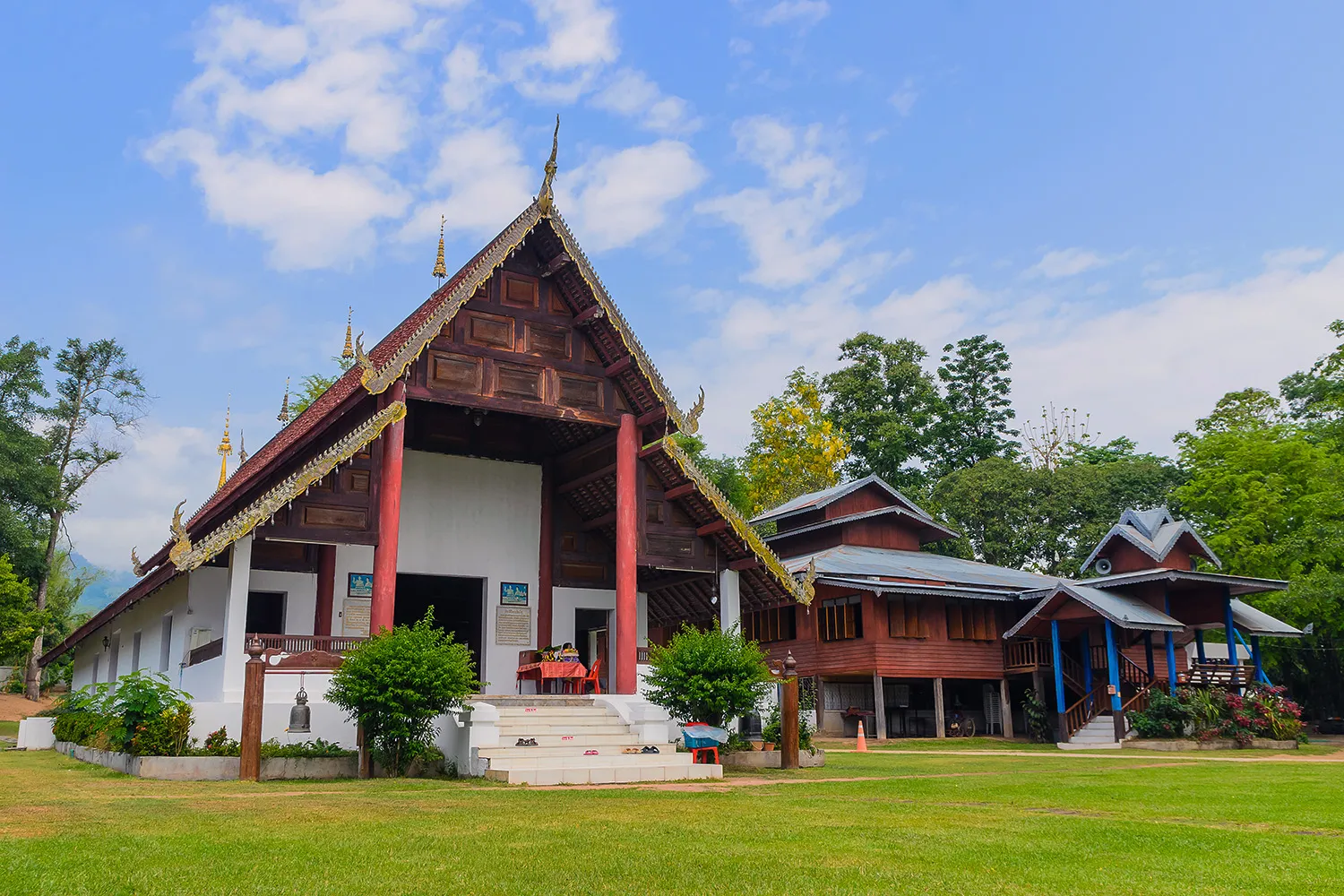
Wat Luang Temple:
Nestled gracefully within the heart of Pai city, the esteemed Wat Luang Temple stands as a bastion of reverence and heritage. With a history that spans over two centuries, its foundations were laid down approximately in the year 2346. This venerable temple exudes an aura of respectability, offering a profound glimpse into the spiritual and architectural tapestry of the region. Dominating the temple’s skyline is a majestic pagoda, an embodiment of Shan style that stands as a testament to artistic ingenuity and devotion. Adorning the pagoda is a captivating square structure crowned with a gracefully tapering spire, an architectural masterpiece that captivates the eye and spirit alike. Conveniently situated within the bounds of Pai’s municipal area, Wat Luang Temple extends an open invitation to all who seek solace, reflection, and connection. Its storied history and spiritual significance create a haven of tranquility amidst the bustling surroundings of the city. As visitors tread upon its hallowed grounds, a sense of awe and reverence permeates the air, offering a profound encounter with both the past and the eternal. In summary, Wat Luang Temple stands as a venerable beacon within Pai city, a haven of heritage and devotion that spans centuries. With its resplendent pagoda and sacred spaces, it captures the essence of the region’s artistic and spiritual heritage. Conveniently accessible to all, it serves as a timeless sanctuary, inviting both locals and visitors to partake in its rich tapestry of reverence and reflection.
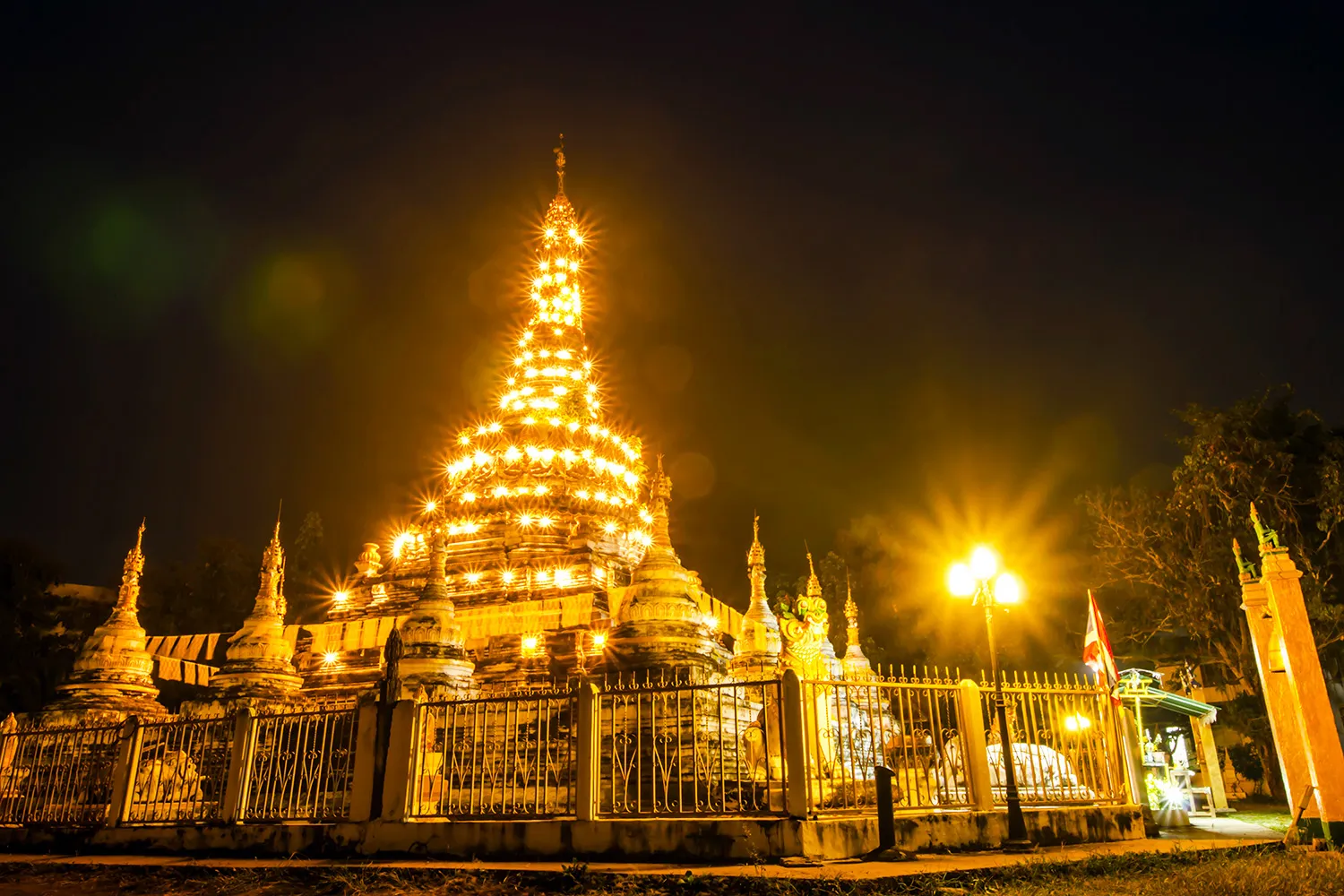
Wat Phra That Mae Yen Temple:
Perched atop the lofty hill of Mae Yen village within Huai Hee sub-district, the resplendent Wat Phra That Mae Yen Temple commands a panoramic vantage point. This elevated sanctuary offers a spectacular panorama that embraces the entirety of Pai city, inviting visitors to indulge in a visual feast of natural beauty. At this elevated perch, a sweeping vista unfolds, captivating the senses with the lush tapestry of Pai’s landscape. As the eye traces the undulating contours, the cityscape comes alive, revealing its intricate nuances against the backdrop of the horizon. The allure of Wat Phra That Mae Yen Temple is further heightened as the day’s end approaches, heralding the arrival of sunset. In these precious moments, the setting sun bathes the expanse in a cascade of golden hues, transforming the horizon into a breathtaking canvas. The mountains, their silhouettes etched against the sky, add depth and grandeur to the scene. It is in this wondrous conjunction of light and land that a masterpiece is unveiled—a scene of unparalleled beauty and awe. As visitors stand witness to this enchanting spectacle, an indelible image is etched into memory. The radiant sun, casting its final glow over the landscape, paints an evocative tableau that lingers in the heart and mind. The majesty of nature’s artistry, in harmonious union with the temple’s serene presence, fosters an experience that transcends time.
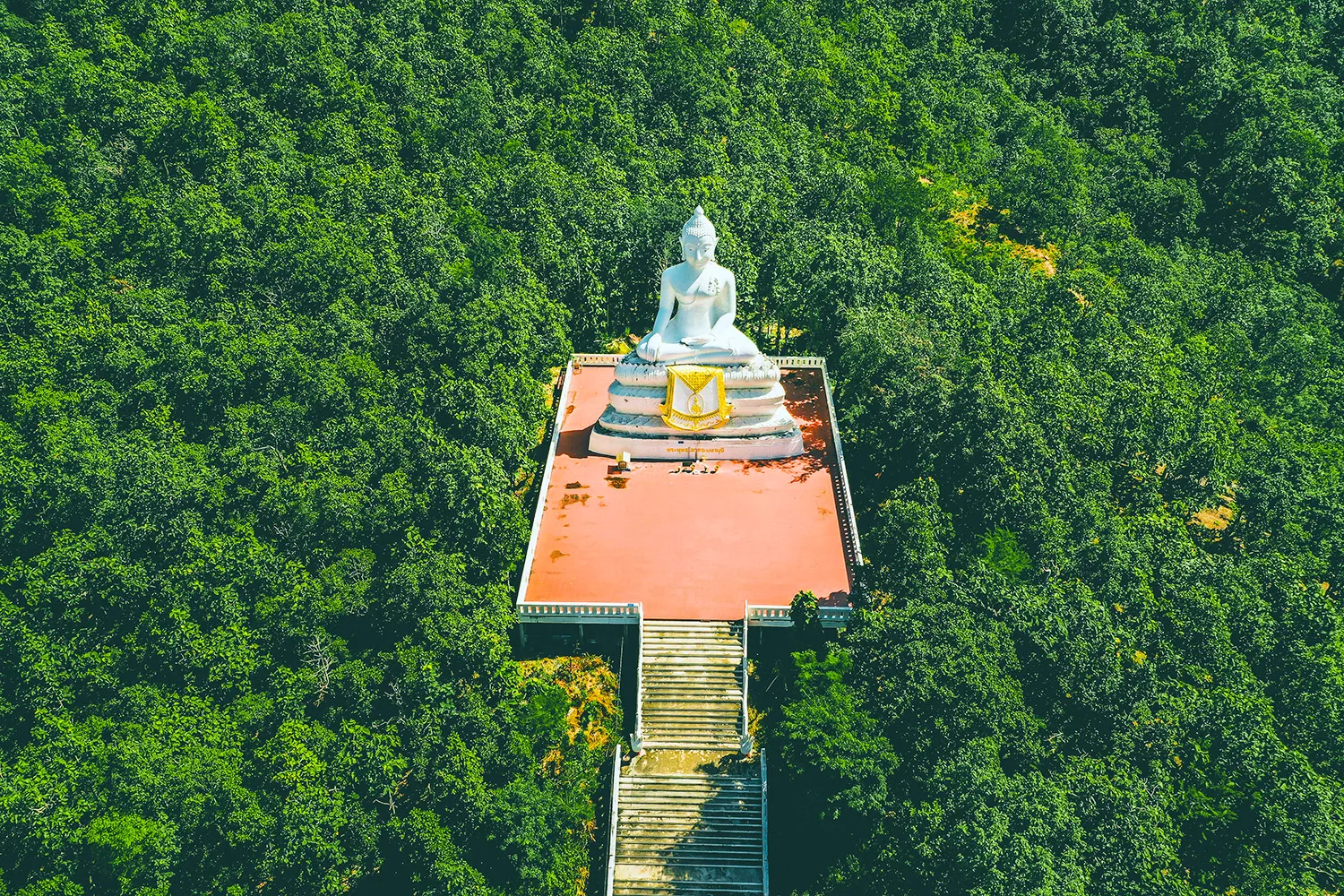
Doi Mieng Viewpoint:
Perched atop the preserved expanse of Thung Yao sub-district, the Doi Mieng viewpoint unveils its allure at an elevation of 1,600 meters above the sea’s embrace. Here, a symphony of nature unfolds, embracing the characteristics of a lush tropical rainforest. The rugged mountains, reaching skyward, are adorned with a rich tapestry of diverse vegetation. This haven of natural splendor awaits the embrace of conservation-conscious travelers, offering a sanctuary of shade and invigorating freshness. The distinctive charm of Doi Mieng is further underscored by its captivating panorama. A vantage point of stunning beauty, it grants visitors the privilege of gazing upon the picturesque tableau of Pai and its surroundings. As the eyes wander, a sense of wonder is evoked, a testament to nature’s artistic prowess. One of the crown jewels of Doi Mieng’s seasonal allure is its embrace of Prunus cerasoides, which flourishes in resplendent bloom during January. The sight of these delicate blossoms adds an ethereal touch to the landscape, as if nature herself has painted the canvas with meticulous care. For those seeking a deeper immersion, the prospect of spending the night in this enchanting realm beckons. Accommodations and tents dot the landscape, offering a unique opportunity to slumber amidst nature’s embrace. However, during the winter season, the demand often exceeds supply, making reservations a prudent choice for those who wish to bask in the tranquility of Doi Mieng overnight. Alternatively, the vibrant town of Pai extends its warm embrace, offering a convenient haven for those who choose to explore the delights of Doi Mieng during the day.
